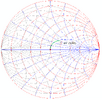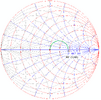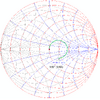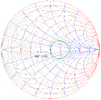The general idea is that when a coax is n/2λ, n being any whole number, with the opposite end of the coax an open, the input will also appear as an open. If this is in parallel with a 50Ω dummy load (the tee), when the coax is trimmed to that half wave multiple, the radio will only see the dummy load and give a 1:1 match. We can use this to trim the cable to our desired multiple. There exists only one remaining issue, that is the coax has loss and there will be a range of frequencies (inches of trim) that provide a 1:1 match. This is the purpose of the 10m radio. Start out at 28.5MHz, see how many inches of coax trimming it takes from the point the needle hits 1:1 through the point it lifts back off 1:1. With this knowledge, we can stop trimming at our desired frequency as soon as 1:1 is reached. From there, take the number of inches coax determined when trimming at 10m, divide it by 2, add the length of that half of the coax tee, then subtract what your connector will add.
A nanoVNA could accomplish the same job in a few seconds, be sure to tell santa you want one...




